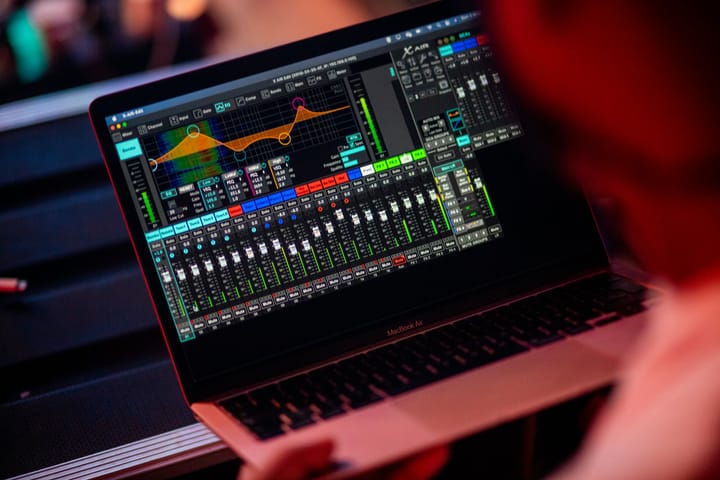Best Software for Podcast Recording in 2024
In the ever-evolving world of podcasting, selecting the right software is crucial for producing high-quality content that captivates your audience.


Key Takeaways:
- Adobe Audition offers robust features: "With multi-track recording capabilities, real-time editing tools, and a vast library of audio effects, Audition offers everything you need to produce high-quality podcasts."
- Hindenburg Journalist is ideal for beginners: "Its intuitive interface and automatic leveling feature make it ideal for beginners, while advanced users will appreciate its extensive editing capabilities."
- Audacity is versatile and budget-friendly: "Despite being free and open-source, Audacity offers a comprehensive set of features, including multi-track recording, audio effects, and noise reduction tools."
In the ever-evolving world of podcasting, selecting the right software is crucial for producing high-quality content that captivates your audience. While many podcasters focus on content creation, the choice of recording software can significantly impact the overall quality and professionalism of your podcast. With advanced features such as multi-track recording, noise reduction, and real-time editing, the best software options available in 2024 offer everything you need to take your podcast to the next level.
Fact: High-Resolution Audio Matters
Did you know that podcast recording software impacts not only your content but also your discoverability? Aim for 48 kHz audio resolution to enhance sound quality. Additionally, consider video—720p HD is the minimum, but 1080p or 4K elevates your visual appeal.
Best Software for Podcast Recording in 2024:
Adobe Audition:
- Adobe Audition stands out as one of the best options for professional podcasters, offering a comprehensive suite of features tailored to audio production. With its intuitive interface and powerful tools, Audition provides everything you need to produce studio-quality podcasts. To achieve your podcasting goals with Adobe Audition:
- Use multi-track recording to capture separate audio channels for each speaker or element of your podcast.
- Take advantage of real-time editing tools to make adjustments on the fly and streamline your workflow.
- Explore the vast library of audio effects to enhance the sound quality and add depth to your podcast episodes.
- Audacity This open-source software is a common choice for podcast recorders. It is free, easy to use, and offers good basic storage options. However, it can be a bit tedious and lacks some of the advanced features found in paid software.
- GarageBand If you're a Mac user, GarageBand is a great free option that comes pre-installed on your computer. It offers a user-friendly interface and a surprising amount of features for recording and editing audio. However, it's not as powerful as some of the paid options on the market.
- Riverside This cloud-based platform is a great option for recording remote interviews. It offers features like call recording, live editing, and video conferencing. However, it can be expensive for solo podcasters, and the free plan has limited features.
- Hindenburg Journalist This software is specifically designed for podcasters and offers a number of features that make it easy to record, edit, and produce your show. However, it is also one of the most expensive options on this list.
Other factors to consider when choosing podcast recording software:
- Number of guests: If you'll be recording interviews with multiple guests, you'll need software that can handle multi-track recording.
- Editing needs: If you plan on doing a lot of editing, you'll need software with a good selection of editing tools.
- Ease of use: If you're a beginner, you'll want to choose software that is easy to learn and use.
- Budget: Podcast recording software can range in price from free to hundreds of dollars per month.
Hindenburg Journalist:
- Hindenburg Journalist is designed with simplicity and efficiency in mind, making it an excellent choice for both beginners and experienced podcasters. Its intuitive interface and automatic leveling feature allow you to focus on creating content without getting bogged down by technical complexities. To make the most of Hindenburg Journalist:
- Utilize the automatic leveling feature to ensure consistent audio levels throughout your podcast episodes.
- Take advantage of the streamlined workflow to quickly edit and enhance your audio without unnecessary hassle.
- Experiment with the extensive editing capabilities to fine-tune your podcast and create a polished final product.
Audacity:
- Audacity remains a popular choice among podcasters for its versatility and budget-friendly nature. Despite being free and open-source, Audacity offers a comprehensive set of features that rival even some paid software options. To leverage Audacity for your podcasting needs:
- Use multi-track recording to capture multiple audio sources simultaneously and create a dynamic listening experience.
- Explore the wide range of audio effects and plugins available to customize your podcast's sound and style.
- Take advantage of the built-in noise reduction tools to clean up your audio and improve overall quality.
Mac-Specific
- Unified Design Aesthetic: Apple products are known for their sleek, minimalist design. Mac computers often feature aluminum unibody construction, thin profiles, and attention to detail in design elements like keyboard layout and trackpad ergonomics.
- Retina Displays: Many Macs come with Retina displays, which offer high pixel density and sharp image quality, making text and graphics appear smooth and crisp.
- Trackpad Gestures: macOS supports a wide range of multi-touch gestures on the trackpad, allowing users to perform actions like pinch-to-zoom, swipe between full-screen apps, and three-finger swipe to switch between desktops.
- Time Machine: This built-in backup solution makes it easy to back up and restore files, applications, and the entire system to an external drive. It's known for its simplicity and ease of use.
- iCloud Integration: macOS seamlessly integrates with Apple's cloud storage and synchronization service, iCloud. This allows for automatic synchronization of files, photos, calendars, and more across Macs and iOS devices.
- Continuity Features: macOS and iOS devices support continuity features such as Handoff (start a task on one device and finish on another), Universal Clipboard (copy on one device, paste on another), and AirDrop (wireless file sharing between Apple devices).
- Mission Control: This feature provides a bird's-eye view of all open windows, spaces (virtual desktops), and full-screen apps, making it easy to navigate and organize multiple tasks.
- Spotlight Search: Spotlight is a powerful search tool that can quickly find files, apps, contacts, emails, and more. It also provides information from the web, such as weather and sports scores.
- Security and Privacy: macOS incorporates robust security features such as Gatekeeper (which validates apps), FileVault (full-disk encryption), and Privacy Preferences (controls over app access to personal data).
- Built-in Apps: macOS comes with a suite of built-in apps such as Safari (web browser), Mail (email client), Messages (instant messaging), FaceTime (video and audio calls), and more, which are designed to work seamlessly with the system.
Adobe Audition:
- Multitrack Editing: Audition allows for multitrack editing, which means you can work with multiple audio tracks simultaneously. This is essential for creating complex audio mixes, podcasts, and soundtracks.
- Waveform Editing: You can edit audio waveforms directly, adjusting amplitude, applying fades, trimming, cutting, copying, and pasting audio segments with precision.
- Noise Reduction and Restoration: Audition includes advanced tools for noise reduction, such as spectral frequency display, noise reduction effects, and automatic noise removal features. It also offers tools for audio restoration to repair damaged audio files.
- Audio Effects and Plugins: It comes with a wide range of built-in audio effects and supports third-party VST/AU plugins, allowing users to apply effects like reverb, EQ, compression, and more to enhance audio quality.
- Audio Recording: Audition supports multi-channel audio recording from external sources such as microphones and digital interfaces. It provides real-time monitoring and metering to ensure accurate recording levels.
- Batch Processing: You can apply edits, effects, and adjustments to multiple audio files simultaneously using batch processing features, saving time and effort when working with large numbers of files.
- Audio Restoration: Audition includes tools for audio cleanup and restoration, such as the ability to remove clicks, pops, hums, and other unwanted noise from recordings.
- Spectral Frequency Display: This feature allows you to visualize audio frequencies in a graphical interface, making it easier to identify and edit specific audio frequencies and areas.
- Audio Ducking: Audition includes tools for automated audio ducking, which adjusts the volume of background music or sound effects based on dialogue or narration levels, ensuring clarity in audio mixes.
- Video Soundtrack Editing: You can import video files directly into Audition for editing their audio tracks. This integration is particularly useful for video editors who need precise control over audio elements in their projects.
- Podcast Creation Tools: Audition offers features tailored for podcast production, including automatic loudness correction, voiceover recording, and publishing directly to podcast hosting platforms.
- Integration with Adobe Creative Cloud: Audition seamlessly integrates with other Adobe Creative Cloud applications like Premiere Pro, After Effects, and Photoshop, allowing for a smooth workflow between video and audio editing tasks.
FAQ:
Q: Can I use these software options on Mac and PC?
A: Yes, Adobe Audition, Hindenburg Journalist, and Audacity are all compatible with both Mac and PC operating systems.
Q: Do I need to purchase a separate license for each software?
A: Adobe Audition and Hindenburg Journalist require a one-time purchase or subscription, while Audacity is free to use without any licensing fees.
Q: Are there any limitations to the free version of Audacity?
A: The free version of Audacity offers the same features as the paid version, with no limitations on functionality. However, donations to support ongoing development are appreciated.
Billionviews.ai is a video editor recruiting platform. Discover video editors who can meet your style preferences, budget, and deadlines. Once you post a job, applicants are rated based on their samples. Post your job on Billionviews.ai today for free!


